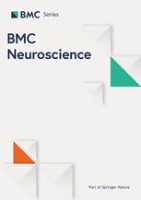
BMC NEUROSCIENCE
Scope & Guideline
Bridging Gaps in Neuroscience Knowledge for All
Introduction
Aims and Scopes
- Neuroimaging and Neurophysiology:
Research focusing on advanced imaging techniques such as fMRI, EEG, and PET scans to explore brain structure and function, and how these relate to various neurological conditions. - Neuropharmacology:
Studies investigating the effects of drugs on the nervous system, including therapeutic interventions for neurodegenerative diseases, pain management, and psychiatric disorders. - Neurodevelopmental and Neurodegenerative Disorders:
Research centered on understanding the mechanisms, biomarkers, and treatment strategies for conditions such as Alzheimer's disease, autism spectrum disorders, and Parkinson's disease. - Neuroinflammation and Neuroimmune Interactions:
Investigations into the role of inflammatory processes in neurological disorders, including the impact of the immune system on brain health and disease progression. - Cognitive and Behavioral Neuroscience:
Studies examining the neural correlates of cognitive functions, emotional regulation, and behavior, using both experimental and computational approaches. - Neuroethics and AI in Neuroscience:
Exploration of ethical considerations in neuroscience research, particularly with the integration of artificial intelligence and machine learning methodologies. - Experimental Models of Neurological Disorders:
Development and characterization of animal models to study the pathophysiology and potential therapeutic interventions for various neurological conditions.
Trending and Emerging
- Artificial Intelligence and Machine Learning in Neuroscience:
There is an increasing trend towards utilizing AI and machine learning algorithms to analyze complex neuroimaging data, predict treatment outcomes, and enhance diagnostic accuracy in various neurological conditions. - Neuroinflammation and Immune System Interactions:
Research on the interplay between the nervous and immune systems is gaining traction, particularly in understanding the role of neuroinflammation in neurodegenerative diseases and psychiatric disorders. - Neurotechnology and Rehabilitation:
Innovations in neurotechnology, such as brain-computer interfaces and neurostimulation techniques, are emerging as critical areas of research aimed at improving rehabilitation outcomes for individuals with neurological impairments. - Personalized Medicine in Neurology:
An emphasis on personalized treatment strategies based on individual patient profiles is becoming more prevalent, particularly in the context of neurodegenerative diseases and mental health disorders. - Neuroscience of Mental Health and Resilience:
There is a growing focus on understanding the neural mechanisms underlying mental health conditions and resilience, with an emphasis on how lifestyle factors and interventions can promote mental well-being.
Declining or Waning
- Traditional Neuroanatomy:
Research primarily focused on classical neuroanatomical studies has decreased, likely due to the rise of modern imaging techniques that provide more dynamic insights into brain structure and function. - Pharmacogenomics in Neuroscience:
While still relevant, the integration of pharmacogenomics—tailoring drug treatments based on genetic profiles—has seen diminished attention as the field pivots towards broader neuropharmacological studies. - Basic Neurobiology without Clinical Relevance:
Studies that focus solely on basic neurobiology without clear clinical implications have become less frequent, as there is a growing emphasis on translational research that connects laboratory findings with clinical applications. - Animal Behavior Studies in Isolation:
Research focusing on animal behavior without consideration of environmental or social contexts is waning, as the field shifts towards more integrative approaches that consider the impact of such factors on neurobiology.
Similar Journals

ASN Neuro
Championing High-Impact Research in Neurology and NeuroscienceASN Neuro is an esteemed academic journal published by Frontiers Media SA, focusing on critical advancements in the fields of neurology and neuroscience. Since its inception in 2009, it has established itself as an Open Access platform dedicated to fostering the dissemination of knowledge and research findings that address the complexities of the nervous system. With an impressive impact factor and consistently ranking in the top quartiles of its categories—Q1 in Neurology (clinical) and Q2 in Neuroscience (miscellaneous)—ASN Neuro is recognized for its high-quality publications that cater to the evolving challenges in clinical neurology and general neuroscience. Currently, it ranks 68th out of 400 journals in Clinical Neurology and 28th out of 113 in General Neuroscience, affirming its reputable position within the academic community. Researchers, professionals, and students alike are encouraged to contribute to and benefit from this impactful journal as it presents a unique opportunity to engage with cutting-edge research, innovative methodologies, and insightful reviews in the ever-evolving landscape of brain science.

Science Bulletin
Exploring the frontiers of multidisciplinary research.Science Bulletin is a premier multidisciplinary journal published by Elsevier, renowned for its commitment to advancing scientific knowledge across various fields. With an impressive impact factor and achieving a distinguished Q1 category ranking in 2023 within its multidisciplinary scope, Science Bulletin stands out for its rigorous peer-review process and high-quality research dissemination. Since its inception in 2015, the journal has been pivotal in bridging gaps between diverse scientific disciplines, fostering collaboration and innovation. Researchers and professionals can benefit from its Open Access options, ensuring wider visibility and accessibility of groundbreaking research. With a Scopus rank of #4 out of 171, placing it in the 97th percentile, Science Bulletin continues to set the standard for scholarly excellence, making it an essential resource for those seeking to stay at the forefront of scientific discovery.

NEUROBIOLOGY OF DISEASE
Advancing Insights into Neurobiological MechanismsNEUROBIOLOGY OF DISEASE is a premier journal dedicated to advancing the understanding of neurological disorders and the underlying biological processes, published by Academic Press Inc, Elsevier Science. With an impressive impact factor indicative of its significance—ranked in the Q1 quartile in Neurology for 2023 and occupying the 14th rank out of 192 journals in the field of Neuroscience and Neurology—this journal serves as a critical resource for researchers, clinicians, and students alike. The journal has a rich history since its inception in 1994, continuously evolving its scope to encompass groundbreaking research and insights into neurobiological mechanisms and disease pathology. Though it currently does not provide Open Access options, NEUROBIOLOGY OF DISEASE remains a vital vessel for disseminating knowledge that significantly contributes to the field of neurology, fostering an understanding that can lead to innovative therapeutic strategies.

NeuroSci
Transforming Neuroscience with Accessible ResearchNeuroSci is an esteemed open-access journal published by MDPI, dedicated to advancing the field of neuroscience through high-quality research dissemination. Operating under the E-ISSN 2673-4087, this journal aims to foster collaboration and innovation by providing a platform for original research articles, reviews, and theoretical studies that address the complexities of the brain and nervous system. NeuroSci encourages submissions from a wide array of disciplines including cognitive neuroscience, neurobiology, neurophysiology, and neuropsychology, making it an essential resource for researchers, professionals, and students alike. With its commitment to open accessibility, NeuroSci ensures that groundbreaking findings are readily available to the global community, thereby enhancing the impact and exchange of knowledge in neuroscience. The journal is located at ST ALBAN-ANLAGE 66, CH-4052 BASEL, SWITZERLAND, contributing to the reputation of MDPI as a leading publisher in the academic landscape.

Brain Communications
Connecting Minds, Unlocking PotentialBrain Communications is an esteemed, open-access academic journal published by Oxford University Press since 2019, focusing on the dynamic field of neuroscience. With a dedicated ISSN and an E-ISSN of 2632-1297, this journal aims to address the intricate relationships between brain functions, psychiatric disorders, and neurobiological mechanisms. The journal stands out in the academic realm, holding a prestigious Q1 ranking across several categories, including Biological Psychiatry, Cellular and Molecular Neuroscience, Neurology, and Psychiatry and Mental Health for 2023. Notably, it has also secured impressive Scopus ranks in various neuroscience and psychiatry fields, evidencing its commitment to high-quality research. With an impact factor reflective of its growing influence, Brain Communications provides accessible research findings to professionals, researchers, and students alike, fostering a deeper understanding of complex neurological phenomena. This innovative journal is pivotal for anyone involved in advancing knowledge in neuroscience and mental health.

Frontiers in Neuroscience
Empowering global collaboration in brain research.Frontiers in Neuroscience, published by FRONTIERS MEDIA SA, is a premier open-access journal dedicated to advancing our understanding of the nervous system through innovative and rigorous research. Since its inception in 2007, this journal has become an influential platform for researchers, featuring a diverse range of topics across various subfields of neuroscience. With its current ranking in the second quartile (Q2) of the category "Neuroscience (miscellaneous)" and a commendable position of #40 out of 113 in general neuroscience according to Scopus, Frontiers in Neuroscience is recognized for its high-impact contributions. The journal promotes free access to scholarly work, ensuring that cutting-edge neuroscience studies reach a global audience and foster collaboration across disciplines. By bridging gaps in knowledge and facilitating the exchange of ideas, Frontiers in Neuroscience plays a pivotal role in addressing the complexities of the nervous system and its effects on behavior, cognition, and health.

SYNAPSE
Unlocking the Secrets of the Nervous SystemSYNAPSE, an esteemed journal in the field of Cellular and Molecular Neuroscience, is published by Wiley and serves as a vital platform for disseminating groundbreaking research in neuroscience. Established in 1987, this journal has been pivotal in exploring the intricate mechanisms governing synaptic function and neural communication, contributing to our understanding of the nervous system. With an ISSN of 0887-4476 and an E-ISSN of 1098-2396, SYNAPSE is indexed in Scopus and currently holds a Q4 quartile ranking in its category, reflecting its niche yet significant presence within the research community. Despite its recent ranking in the 21st percentile among its peers, the journal’s commitment to quality and innovation remains unwavering. It is published from Hoboken, New Jersey, and although it is not an open-access journal, it provides invaluable insights and critical reviews that are pivotal for researchers, professionals, and students alike who seek to advance their knowledge in the dynamic field of neuroscience. Join us in contributing to the ever-evolving discourse in cellular and molecular neuroscience through SYNAPSE.

NEUROSCIENCE AND BIOBEHAVIORAL REVIEWS
Exploring the nexus of cognition and neural processes.NEUROSCIENCE AND BIOBEHAVIORAL REVIEWS, published by PERGAMON-ELSEVIER SCIENCE LTD in the United Kingdom, serves as a leading interdisciplinary platform for the dissemination of pioneering research and reviews in the realms of Neuroscience, Behavioral Neuroscience, Cognitive Neuroscience, and Neuropsychology. With an impressive impact factor reflected in its Q1 ranking across multiple categories for 2023, the journal is recognized for its rigorous peer-reviewed content that influences the advancement of scientific knowledge in behavioral and cognitive research. An essential resource for researchers, professionals, and students alike, the journal emphasizes the exploration of complex neural mechanisms that underlie behavior and cognitive processes. Despite being a subscription-based publication, the journal's extensive archive from 1978 to 2024 fosters a wealth of knowledge designed to inspire and facilitate future advancements within the field.

Review Journal of Autism and Developmental Disorders
Bridging disciplines for a comprehensive understanding.Review Journal of Autism and Developmental Disorders, published by Springer Heidelberg, stands as a leading platform for the dissemination of groundbreaking research in the realm of autism and developmental disorders. With an ISSN of 2195-7177 and an E-ISSN of 2195-7185, this journal not only showcases high-quality research but also emphasizes the crucial intersections between behavioral neuroscience, cognitive neuroscience, developmental neuroscience, and psychiatry. Notably, the journal has achieved a prestigious Q1 ranking across these categories, reflecting its impact and relevance; it ranks 10th in behavioral neuroscience and 5th in developmental neuroscience within Scopus metrics. Spanning from 2014 to 2024, the journal is dedicated to fostering a deeper understanding of autism spectrum disorders and related conditions, making it indispensable for researchers, clinicians, and students alike. While it operates under a traditional access model, the quality of the peer-reviewed articles ensures that it remains a valuable resource in the academic community.

NEUROSCIENCE LETTERS
Transforming Research into Neurological Understanding.NEUROSCIENCE LETTERS is a distinguished journal published by ELSEVIER IRELAND LTD, focusing on disseminating impactful research across the field of neuroscience. With its ISSN 0304-3940 and E-ISSN 1872-7972, the journal serves as a vital platform for researchers, professionals, and students aiming to explore the complexities of nervous system function and related disorders. Since its inception in 1975, NEUROSCIENCE LETTERS has contributed significantly to the field, currently positioned in the Q3 category for Miscellaneous Neuroscience, with a respectable Scopus rank of 52/113, placing it in the 54th percentile among its peers. The journal is published in Ireland and offers a comprehensive repository of scientific insights, methodologies, and innovative findings that advance our understanding of neurological phenomena. While not an open-access journal, it remains an essential resource for the latest advances in neuroscience research and the academic community’s collective knowledge.